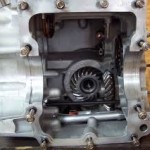 A vehicle with automatic transmission is one that changes gears automatically as the vehicle moves meaning that the driver doesn’t have to do it. You’d be able to recognise an automatic car because where you’d usually see a gear stick with the gears marked on the top, you’ll see something that looks a bit more like a lever – this is automatic transmission gearbox and will have various letters on the casing - including (P) - Park, (R) - Reverse, (N) Neutral or no gear and (D) - drive.
A vehicle with automatic transmission is one that changes gears automatically as the vehicle moves meaning that the driver doesn’t have to do it. You’d be able to recognise an automatic car because where you’d usually see a gear stick with the gears marked on the top, you’ll see something that looks a bit more like a lever – this is automatic transmission gearbox and will have various letters on the casing - including (P) - Park, (R) - Reverse, (N) Neutral or no gear and (D) - drive.
Automatic is the most common form of transmission in the USA; however manual gearboxes have always been more common here in the UK. This is changing though as in recent years more and more cars have been manufactured with either option available for both the markets.
To operate the automatic transmission, a car will need Automatic Transmission Fluid (ATF). This stops corrosive damage, provides essential lubrication and is mostly made up of refined petroleum that has gone through a process that results in properties that assist a smoother transmission and increase the life of the system - although the ATF system will need to be kept in tip-top condition with regular services as the car gets older.
It’s fair to say though, hardly anyone ever makes the effort to change the transmission fluid - in fact many drivers wouldn’t even know where to start looking because it’s usually quite well hidden away.
You’ll know that you need to pay attention to the automatic transmission fluid, if you find that the gear changes aren’t happening as smoothly as you might expect. Ideally, you should really aim to check the ATF once a month anyway so that you can spot any potential issues before they become a real and expensive problem to fix.
To check the Automatic Transmission Fluid (ATF) on your car you should take the following steps:
First of all, make sure that you find out which type of ATF fluid you should be using. This information should be in your owner’s manual - if not contact the manufacturer who should be able to tell you.
- Park your car so that it is level on the ground (slanting in either direction will alter your fluid readings) and leave the gears in either Park or Neutral. This is one of the few procedures that might require an idling engine but it does depend on the car so you need to check your owner’s manual first and find out. If it does require the engine to be running, start the car up and wait for it to warm.
- Locate the ATF dipstick - it is often a lot shorter than the dipstick for the engine oil but should look virtually the same. In some cases it will have a label on it, so your job will be made much easier!
- Take the dipstick outWipe the dipstick down with a cloth or rag, put it back into the hole it came from, make sure it goes all the way back down to the bottom and pull it out again.
- The colour and smell of ATF can also indicate problems. Wipe the fluid onto a white sheet of paper or kitchen towel. It will usually be red, and should be transparent and clean in appearance and free of black bits or flakes. It does become a more reddish-brown with age but should not be dark or black or smell of burning. If the fluid has any of these characteristics, seek professional advice.
- Check the top of the dipstick and see if the fluid marking comes up to the ‘full’ line. Also check that you are looking at the warm reading - there should be one for ‘warm’ and one for ‘cold’.
- If the fluid does not come up to the ‘full’ line then you will need to add some. Remember that ATF shouldn’t be ‘used’ as such, so if it is low, it’s likely that there is a leak. You will need to get this checked out as soon as possible as if left, it can lead to expensive repairs on the transmission system.
- To add the fluid simply use a funnel to pour it into the system (usually the hole will be tiny). You should add it slowly and keep checking the dipstick until it reaches the ‘full’ point. Remember that if you add too much you’ll have a heck of time taking it out again!!
- Make sure the dipstick is back in securely when you’ve finished.









